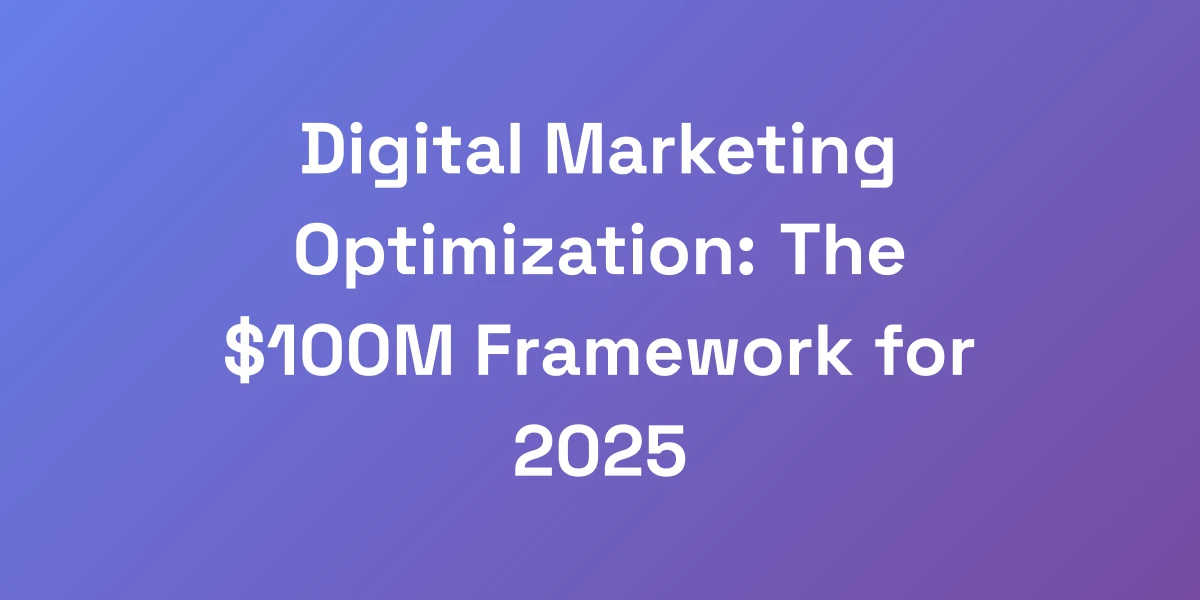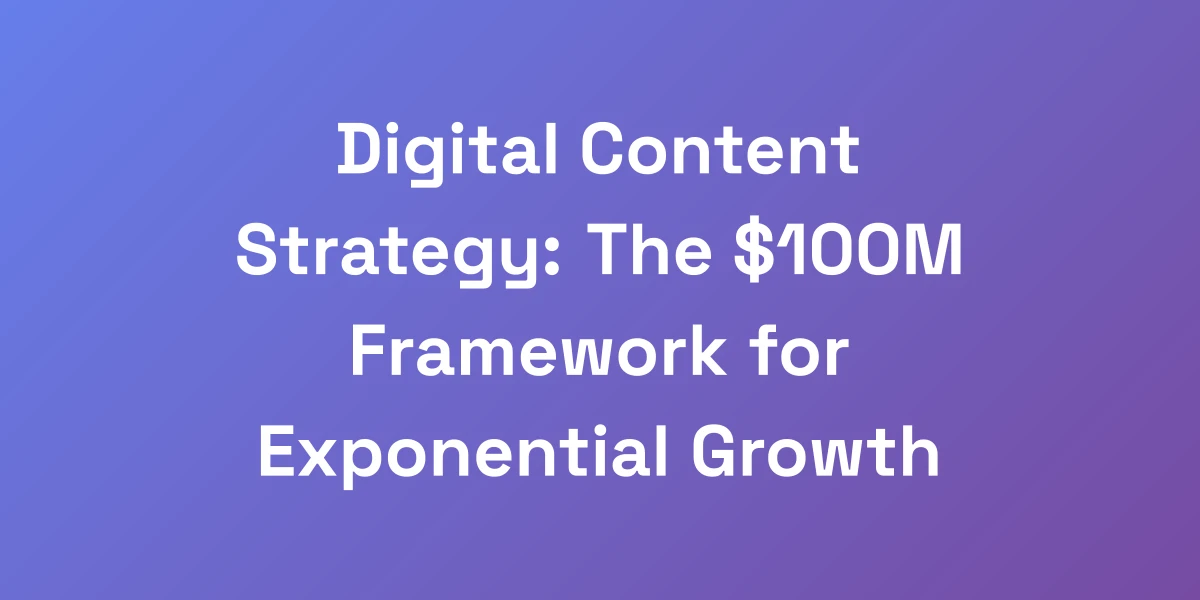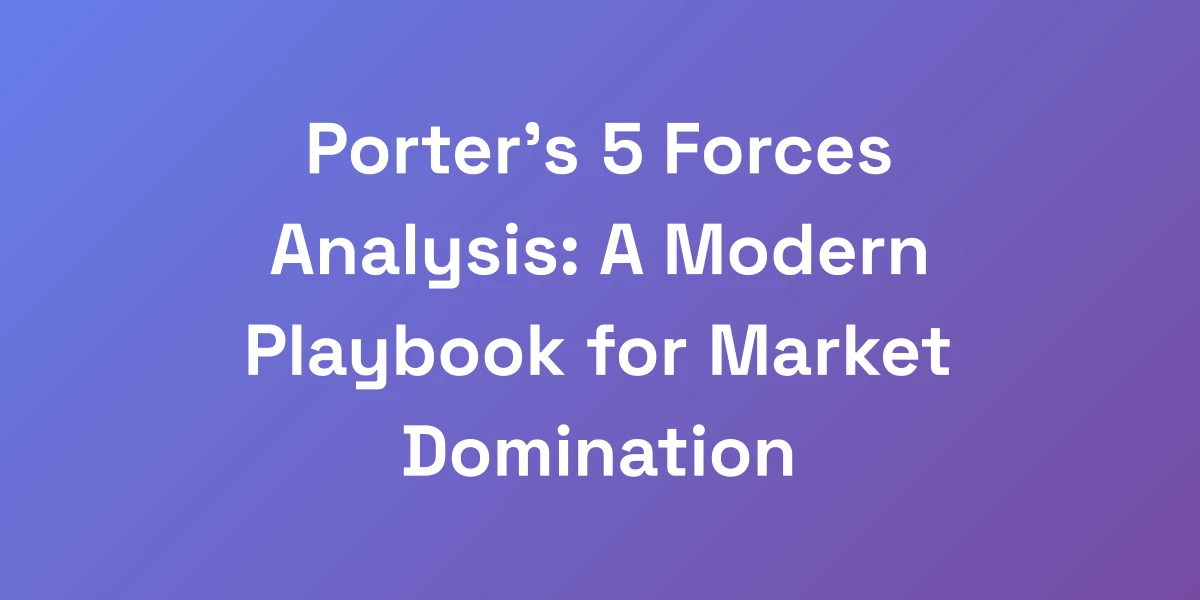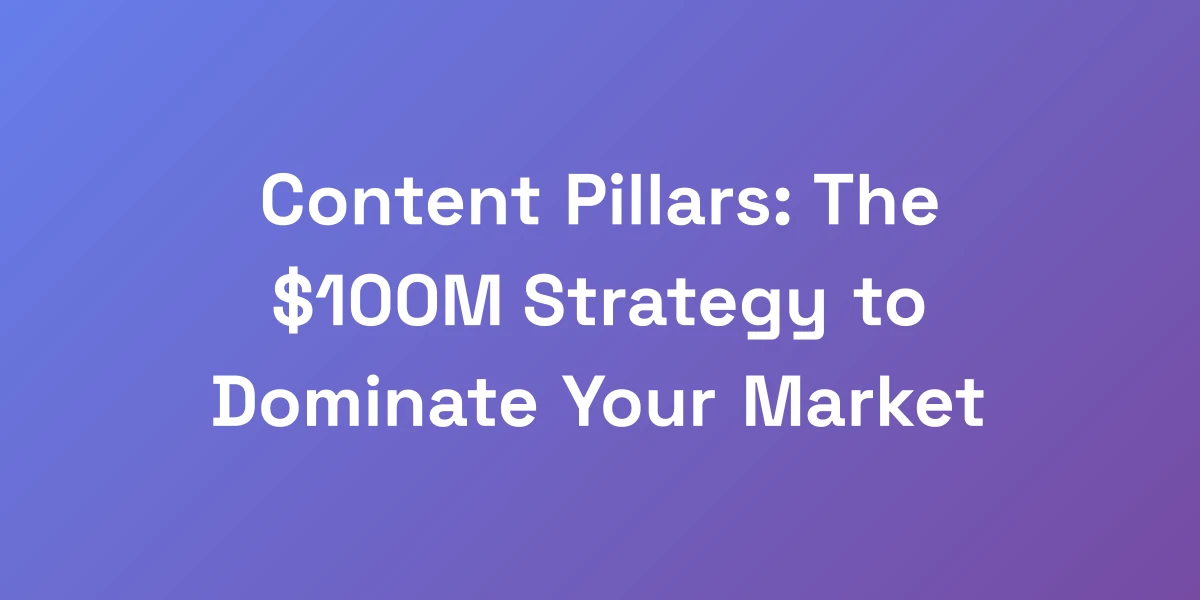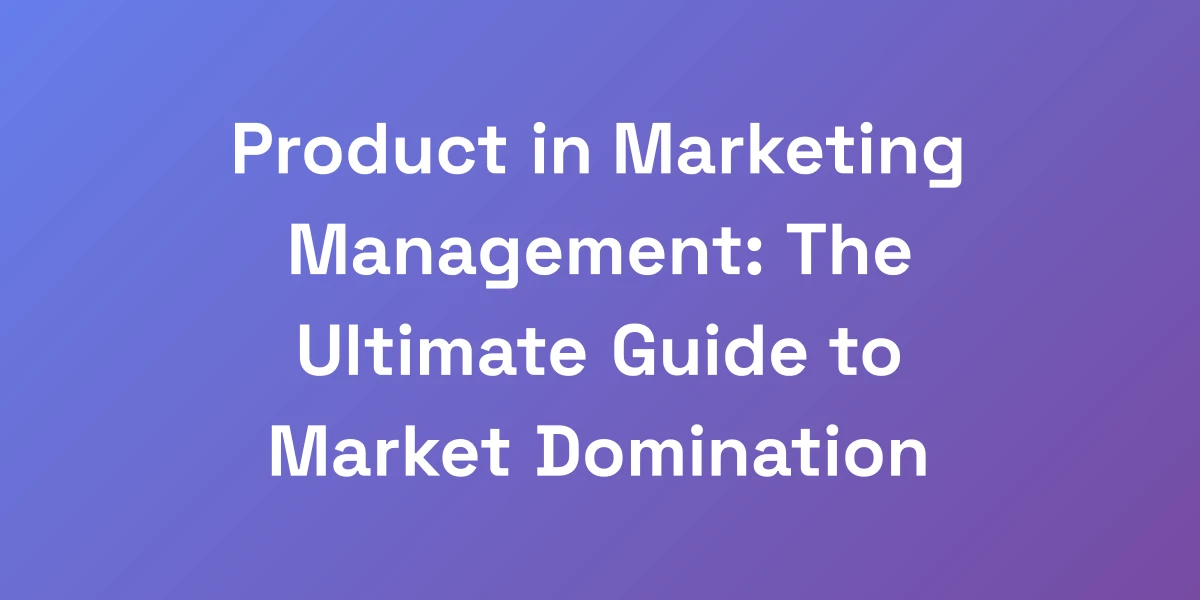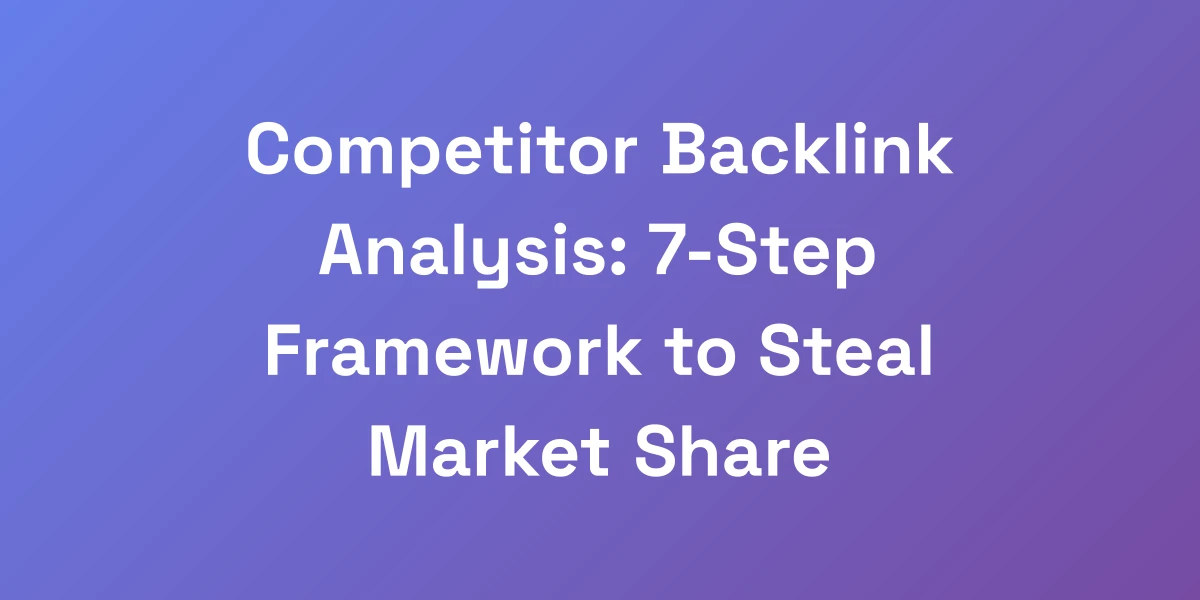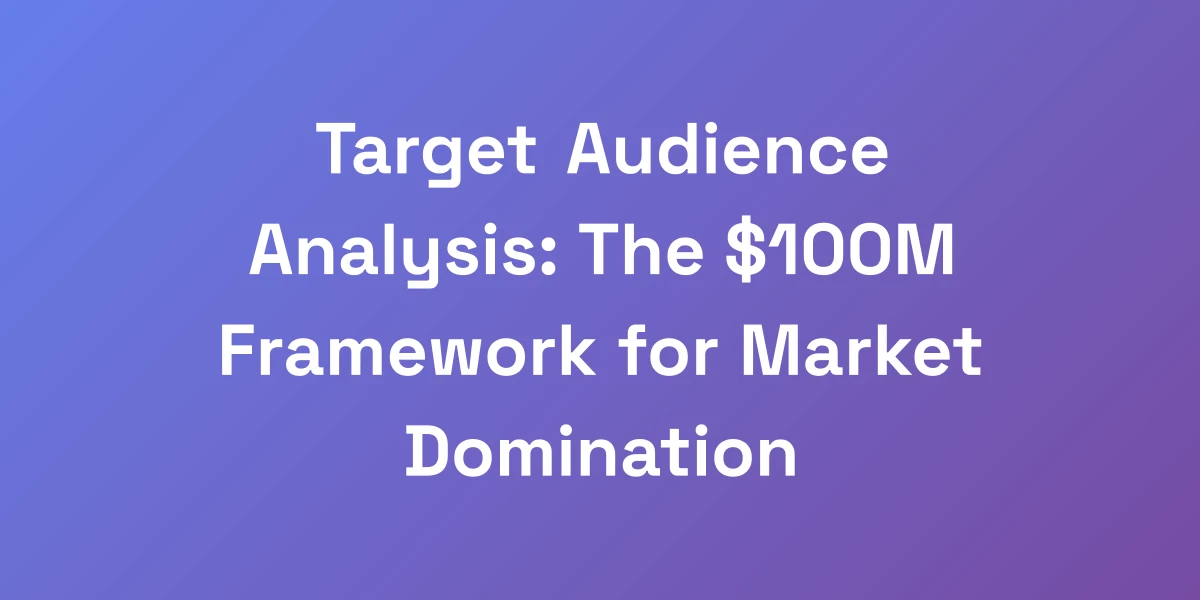
Target Audience Analysis: The $100M Framework for Market Domination
Mar 29, 2025 | By [email protected]
We all know the drill: pouring time, money, and sweat into marketing campaigns, only to watch them fizzle out. It’s frustrating, disheartening, and frankly, downright costly.
But what if we told you there’s a better way? A proven framework that not only identifies your most profitable audience but also propels your business towards $100M+ in revenue?
Welcome to our guide on Target Audience Analysis: the secret weapon behind market domination. We’re breaking down the barriers, cutting through the noise, and giving you the actionable strategies you need to stop wasting resources and start seeing real, measurable results.
Ready to transform your approach? Let’s dive in and uncover the game-changing tactics that will position your business as the undeniable leader in your market.
Why Most Businesses Are Bleeding Money with Wrong Audience Analysis
Let us be direct: 90% of businesses are hemorrhaging money because they’re analyzing the wrong audience signals. We’ve seen companies burn millions chasing demographics that look good on paper but convert like trash.
Here’s the reality – traditional target audience analysis is dead. The old-school “age, gender, location” framework is costing you sales. In this guide, we’re going to show you the exact framework we’ve used to help businesses identify and capitalize on their most profitable audiences, leading to $100M+ in revenue. No fluff, no theory – just battle-tested strategies that work.
The Real Cost of Poor Audience Analysis
Imagine investing thousands, even millions, into a campaign that completely misses the mark. Poor audience analysis leads to misaligned messaging, wasted ad spend, and ultimately, lost revenue.
Consider the backlash faced by Bud Light when they partnered with a transgender influencer. The campaign not only failed marketing campaigns of 2023 to resonate with their core audience but also alienated a significant portion of their customer base. The result? A hit to their brand reputation and potential sales losses that, while not quantified, are undoubtedly substantial.
- Wasted marketing budgets on ineffective campaigns
- Decreased customer trust and brand loyalty
- Missed opportunities for revenue growth
These are not just isolated incidents. They’re the consequences of businesses failing to understand and connect with their true audience.
Why Traditional Demographics Are Killing Your Conversion Rates
For years, marketers have relied heavily on demographics – age, gender, income, location. But here’s the kicker: these factors alone don’t predict buying behavior anymore.
Take Levi’s AI-generated models controversy. By focusing solely on the visual appeal without considering the audience’s perception and values, Levi’s faced backlash for being “lazy” and “problematic.” This oversight highlights the flaw in traditional demographic-based strategies.
- Demographics provide a superficial understanding
- Fail to capture the psychological triggers behind purchases
- Lead to generic marketing messages that don’t resonate
It’s time to move beyond demographics and delve deeper into what truly drives your audience’s purchasing decisions.
The Shift from Demographics to Buying Psychology
The game has changed. Today, understanding the psychological triggers that drive purchasing decisions is paramount. Consumers are influenced by a myriad of internal and external factors that go far beyond basic demographics.
Our research shows that social factors are the most significant influencers of consumer purchasing behavior. This means that tapping into these psychological aspects can dramatically improve your conversion rates.
- Internal motivations: desires, fears, goals
- External influences: social proof, cultural trends
- Behavioral indicators: online interactions, engagement patterns
By focusing on these psychological elements, you can create marketing strategies that resonate on a deeper level, leading to higher engagement and increased sales. This includes specialized approaches such as SEO for startups, which cater specifically to the unique needs of new businesses.
Case Study: How Wrong Audience Analysis Cost My Client $2M
Let us share a real-life example. One of our clients, a mid-sized e-commerce company, was struggling to achieve their sales targets despite a hefty marketing budget. Their traditional audience analysis was focused on broad demographics, which led to generic ad campaigns that failed to engage their audience.
After implementing our $100M Framework for Target Audience Analysis, we shifted the focus to psychological triggers and behavioral indicators. This approach not only refined their target audience but also allowed for more personalized and effective marketing campaigns.
- Identified key psychological drivers behind purchases
- Created tailored marketing messages that resonated with the audience
- Reduced marketing spend wastage by 30%
- Achieved a $2M increase in revenue within six months
This transformation underscores the critical importance of accurate audience analysis and the tangible financial benefits it can bring.
The New Rules of Audience Intelligence
Welcome to the era of advanced audience intelligence. To dominate the market, you need to adopt these new rules:
- Start with psychological triggers, not demographics
- Integrate behavioral data from multiple touchpoints, taking into account the experiment and channel count impact
- Leverage best audience insights tools 2024 for deep audience insights
- Continuously test and validate audience segments
By adhering to these principles, you position your business to not only understand but also predict and influence your target audience’s behavior effectively.
The Psychology-First Audience Analysis Framework
Stop focusing on surface-level data and start diving into what actually drives purchases. The framework we’re about to share isn’t taught in marketing schools – it’s built from analyzing over $100M in sales data.
We’re going to flip the traditional audience analysis model on its head. Instead of starting with demographics, we start with psychological triggers that predict buying behavior with uncanny accuracy. This isn’t about creating cute customer avatars – it’s about identifying the exact signals that indicate someone is ready to buy.
The Three Psychological Buying Triggers
Understanding the core psychological triggers that drive consumer behavior is essential. Here are the three we focus on:
- Fear of Missing Out (FOMO): People are driven by the need to stay relevant and avoid missing out on trends or opportunities.
- Desire for Social Proof: Consumers seek validation from others, making testimonials and reviews powerful tools.
- Aspiration for Self-Improvement: The urge to better oneself leads to purchasing decisions that align with personal growth goals.
By targeting these triggers, we can craft messages that resonate deeply and prompt immediate action.
Mapping Pain Points to Purchase Intent
Every purchase starts with a pain point. Our framework identifies and maps these pain points to the corresponding purchase intents, ensuring that your marketing addresses the real needs of your audience.
- Identify the primary pain points through surveys and social listening
- Align your product features as solutions to these pain points
- Create targeted messaging that speaks directly to these needs
For example, if a client’s audience struggles with time management, positioning their product as a time-saving tool directly addresses this pain point, increasing the likelihood of conversion.
The Behavioral Indicators That Actually Matter
Behavioral data provides insights into how your audience interacts with your brand. But not all data is created equal. Here are the key behavioral indicators we focus on:
- Engagement patterns: How and when your audience interacts with your content
- Purchase history: What, when, and how often they buy
- Online behavior: Pages visited, time spent, and actions taken on your website
By analyzing these indicators, we can predict future behavior and tailor your marketing strategies accordingly.
How to Track and Measure Psychological Signals
Tracking psychological signals requires a combination of tools and methodologies. Here’s how we do it:
- Use advanced social listening tools to monitor conversations and sentiment
- Deploy surveys and feedback forms to gather direct insights
- Analyze behavioral data from your website and CRM systems
By integrating these data sources, we create a comprehensive view of your audience’s psychological landscape.
Building Your Psychological Buyer Profile
With all the data in hand, we build a detailed psychological buyer profile that includes:
- Core motivations and desires
- Primary pain points and challenges
- Preferred communication channels and content types
- Behavioral patterns and purchasing triggers
This profile serves as the foundation for all your marketing efforts, ensuring that every campaign is aligned with the true needs and desires of your target audience.
Advanced Data Mining for Hidden Audience Insights
Your competitors are all looking at the same basic Google Analytics data. That’s why they’re all getting the same mediocre results. We need to go deeper.
We’re going to show you how to mine for audience gold in places your competition doesn’t even know exist. Every platform, every interaction, every customer service ticket is a data point that tells you something about your ideal customer. Here’s how to extract and weaponize that information for maximum profit.
Unconventional Data Sources Your Competitors Miss
While most businesses stick to the obvious data sources, the real insights lie in the unconventional. Think beyond your website analytics:
- Social media interactions and comments
- Customer service interactions and support tickets
- Online forums and community discussions
These sources provide a wealth of information about your audience’s thoughts, preferences, and pain points that traditional data sources might miss.
Advanced Social Listening Techniques
Social listening isn’t just about tracking mentions. It’s about understanding the context and sentiment behind those mentions. Here’s how to do it right:
- Monitor not just your brand, but also competitor brands and industry keywords
- Analyze sentiment to gauge emotional responses
- Identify emerging trends and topics within your audience
Using tools like Brandwatch and Audiense, you can gain deeper insights into what’s driving your audience’s conversations and how you can leverage this information.
Mining Customer Service Interactions for Gold
Your customer service team is a goldmine of information. Every interaction is a data point that can reveal:
- Common pain points and frequently asked questions
- Customer satisfaction and sentiment
- Opportunities for product improvement or new offerings
By systematically analyzing these interactions, you can uncover hidden insights that inform your audience analysis and marketing strategies.
Competitive Intelligence Gathering Methods
Understanding your competitors’ strategies can give you a significant edge. Here’s how to gather actionable competitive intelligence:
- Analyze your competitors’ marketing campaigns and messaging
- Monitor their social media activity and engagement
- Study their customer reviews and feedback
This information helps you identify gaps in the market and opportunities to differentiate your brand effectively.
Tools and Technologies for Deep Audience Analysis
To mine data effectively, you need the right tools. Here are some we recommend:
- Audiense: For advanced audience segmentation and influencer discovery
- Google Analytics 4: For enhanced tracking across websites and apps
- Brandwatch: For long-term trend tracking and social monitoring
- StatSocial: For audience clustering and persona building
- Digital marketing for small businesses
These tools enable you to extract, analyze, and interpret data from various sources, providing a comprehensive view of your target audience.
The Rapid Audience Testing and Validation System
Theory is worthless without validation. We’re going to show you our exact system for testing audience assumptions in the real world, fast and cheap. Most businesses spend months on market research that’s outdated by the time they use it. Instead, we teach you how to validate audience segments in 72 hours with less than $1,000.
This is the same system we’ve used to launch multiple 7-figure products with near-perfect audience alignment.
The 72-Hour Audience Validation Protocol
Speed is crucial. Our protocol ensures you can test and validate your audience segments within just three days:
- Day 1: Define your hypotheses and set up testing parameters
- Day 2: Execute A/B testing examples for startups 2024 across multiple channels
- Day 3: Analyze results and make data-driven decisions
This rapid approach allows you to iterate quickly, refining your audience segments based on real-world data.
Micro-Testing Frameworks for Fast Results
Micro-testing involves small, controlled experiments that provide immediate feedback. Here’s how to implement it:
- Create multiple ad variations targeting different segments
- Run short-duration campaigns to gather initial data
- Analyze performance metrics to identify top-performing segments
By focusing on micro-tests, you can swiftly identify what works and scale up those strategies without wasting resources.
Setting Up Valid Test Parameters
To ensure your tests yield actionable data, set up clear parameters:
- Identify key metrics: conversion rates, engagement, ROI
- Determine the sample size needed for statistical significance
- Establish a timeline that aligns with your validation goals
Proper setup is essential for obtaining reliable and meaningful results that inform your audience analysis.
Interpreting Test Results Accurately
Data doesn’t lie, but interpreting it correctly is critical. Here’s how to ensure accuracy:
- Compare performance against control groups
- Look for patterns and trends in the data
- Consider external factors that might influence results
Accurate interpretation allows you to make informed decisions about which audience segments to focus on.
Scaling What Works, Killing What Doesn’t
Once you’ve identified the winning segments, it’s time to scale. Here’s the process:
- Increase budget allocation to high-performing segments
- Optimize campaigns based on the insights gained
- Phase out or adjust strategies for underperforming segments
- Adopt digital marketing agencies best practices for scalability
By scaling effectively, you maximize your marketing spend and drive substantial revenue growth.
Turning Audience Insights into Revenue
Knowing your audience is useless if you can’t turn that knowledge into cash. Here’s where we transform everything we’ve learned into actionable revenue strategies.
We’ll show you exactly how to take your audience insights and create marketing campaigns that hit psychological triggers with surgical precision. This isn’t about broad appeal – it’s about becoming the obvious choice for your most profitable customer segments.
Creating Irresistible Offers for Your Audience
Offers need to be tailored to your audience’s specific needs and desires. Here’s how to craft them:
- Highlight the unique benefits that address your audience’s pain points
- Create urgency through limited-time offers or scarcity tactics
- Bundle products or services to increase perceived value
When your offers resonate with your audience’s motivations, conversions skyrocket.
Messaging That Triggers Instant Response
Your messaging should tap into the psychological triggers we discussed earlier. Here’s how to do it:
- Use emotional language that connects with your audience’s desires and fears
- Incorporate social proof to build trust and credibility
- Clearly articulate the benefits and outcomes of your product or service
Effective messaging speaks directly to the audience’s inner motivations, driving immediate action.
Channel Selection Based on Audience Behavior
Not all marketing channels are created equal. To maximize impact, select channels based on where your audience spends their time:
- Social media platforms based on social media ROI statistics for younger, digitally-native audiences
- Email for B2B audiences who prefer direct communication
- Content marketing for audiences seeking in-depth information
Choosing the right channels ensures your messages reach your audience where they’re most engaged.
Scaling Strategies That Maintain Audience Focus
Scaling is not just about increasing spend; it’s about maintaining focus on what works. Here’s how to scale without losing alignment:
- Replicate successful campaigns across similar audience segments
- Invest in marketing automation for agencies to manage increased campaign volumes
- Continuously monitor performance to ensure consistency
- Adopt digital marketing agencies best practices for scalability
By scaling effectively, you maximize your marketing spend and drive substantial revenue growth.
Measuring and Optimizing Revenue Impact
Optimization is an ongoing process. To maximize revenue, regularly measure and tweak your strategies:
- Track key performance indicators (KPIs) related to revenue growth
- Conduct A/B testing to refine your campaigns
- Analyze customer feedback to identify areas for improvement
Continuous optimization ensures that your marketing efforts are always aligned with your revenue goals.
Conclusion
We’ve journeyed through the intricate landscape of Target Audience Analysis, unveiling the strategies that separate market dominators from the rest. By shifting from outdated demographic models to a psychology-first approach, leveraging advanced data mining techniques, and implementing rapid testing and validation systems, you’re now equipped to identify and engage your most profitable audiences effectively.
The key takeaways? Understand your audience on a deeper level, utilize unconventional data sources, and translate those insights into actionable revenue strategies. These steps are not just theoretical – they’ve been proven to drive $100M+ in revenue for businesses that dare to implement them.
Now, it’s your turn. Are you ready to transform your audience analysis and dominate your market? Start implementing these frameworks today and watch your business soar.
We’d love to hear about your experiences. What challenges have you faced with audience analysis, and how did you overcome them? Share your thoughts in the comments below and let’s continue the conversation.


